
Micrantheum serpentinum, commonly known as western tridentbush, is a species of flowering plant in the family Picrodendraceae, and is endemic to north-western Tasmania. It is a straggly, monoecious shrub with oblong to narrowly egg-shaped leaves and yellowish to greenish flowers.

Stachystemon is a genus of nine species of flowering plants in the family Picrodendraceae, and is endemic to Western Australia. Plants in the genus Stachystemon are monoecious shrubs with simple, usually thickened leaves, and flowers arranged singly or in small groups in upper leaf axils, male flowers usually with four to six tepals, usually with seven to many stamens, and female flowers with four or six tepals and two styles in each flower.
Bossiaea barbarae is a species of flowering plant in the family Fabaceae and is endemic to Western Australia. It is an erect, compact, spiny shrub with egg-shaped to elliptic or oblong leaves, and deep yellow and bright red flowers.
Hibbertia psilocarpa is a species of flowering plant in the family Dilleniaceae and is endemic to the south-west of Western Australia. It is a shrub with spirally arranged, narrow oblong to linear leaves and yellow flowers usually with four to eight stamens, all on one side two glabrous carpels.
Ricinocarpos crispatus is a species of flowering plant in the family Euphorbiaceae and is endemic to south-western Queensland. It is a monoecious or dioecious shrub with linear leaves and white flowers, arranged either singly, with two to four male flowers, or a single female flower surrounded by one or two male flowers.
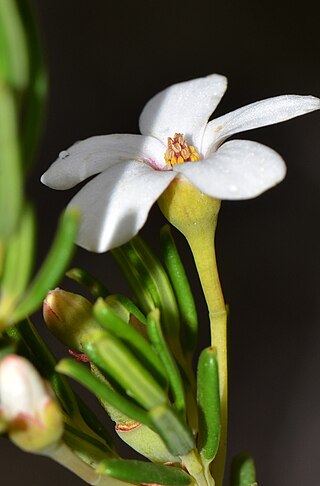
Ricinocarpos cyanescens is a species of flowering plant in the family Euphorbiaceae and is endemic to the south-west of Western Australia. It is a compact, monoecious shrub with narrowly oblong leaves and male and female flowers arranged singly or in small groups.
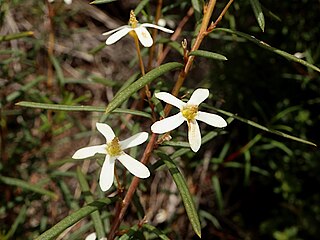
Ricinocarpos glaucus is a species of flowering plant in the family Euphorbiaceae and is endemic to the south-west of Western Australia. It is an erect, monoecious or dioecious shrub with linear or narrowly oblong leaves and male and female flowers arranged singly or in small groups.
Ricinocarpos graniticus is a species of flowering plant in the family Euphorbiaceae and is endemic to the southwest of Western Australia. It is a monoecious shrub with linear leaves and creamy white flowers, arranged either singly, or with a single female flower surrounded by one or two male flowers.
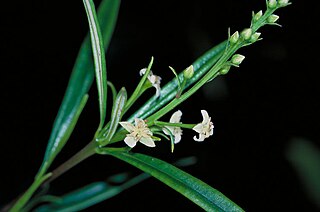
Ricinocarpos ledifolius is a species of flowering plant in the family Euphorbiaceae and is endemic to eastern Queensland. It is a monoecious or dioecious shrub or small tree with linear leaves and white flowers, arranged either singly, or with two or three female or two to six male flowers, or a single female flower surrounded by two male flowers.

Ricinocarpos linearifolius is a species of flowering plant in the family Euphorbiaceae and is endemic to eastern Australia. It is a monoecious or dioecious shrub with hairy young branchlets, linear leaves and white flowers, arranged either singly, with two to four male flowers, or a single female flower surrounded by up to three male flowers.
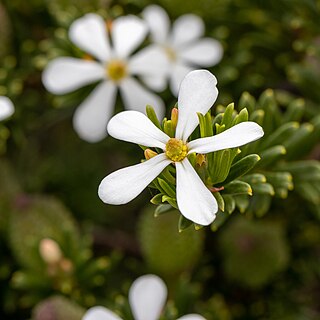
Ricinocarpos megalocarpus is a species of flowering plant in the family Euphorbiaceae and is endemic to the south coast of Western Australia. It is a compact, rounded, usually monoecious shrub with linear leaves and white flowers, arranged either singly, or male flowers in groups, or with a single female flower surrounded by up to six male flowers.
Pseudanthus ballingalliae is a species of flowering plant in the family Picrodendraceae and is endemic to Queensland. It is a monoecious shrub with simple, oblong to narrowly oblong leaves and small yellow male and green female flowers arranged singly in upper leaf axils, but appearing clustered on the ends of branches.
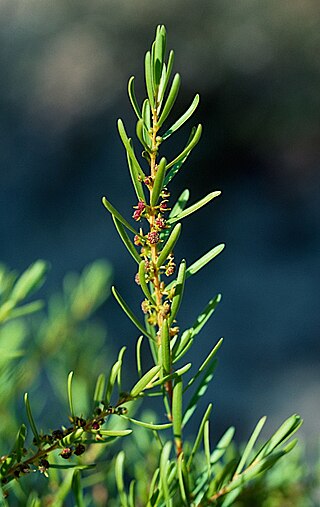
Stachystemon axillaris, commonly known as leafy stachystemon, is a species of flowering plant in the family Picrodendraceae and is endemic to the south-west of Western Australia. It is a monoecious shrub with simple, linear to narrowly elliptic or oblong leaves and small yellow flowers arranged singly in upper leaf axils.

Pseudanthus ligulatus is a species of flowering plant in the family Picrodendraceae and is endemic to northern Queensland. It is a monoecious shrub with simple, lance-shaped or linear to narrowly oblong leaves and creamy white male and pale green female flowers arranged singly in upper leaf axils, but appearing clustered on the ends of branches.
Stachystemon brachyphyllus is a species of flowering plant in the family Picrodendraceae and is endemic to the south-west of Western Australia. It is a monoecious shrub with simple, narrowly elliptic to elliptic or oblong leaves and small yellow, red, purple and brown flowers arranged singly in upper leaf axils.
Ricinocarpos oliganthus is a species of flowering plant in the family Euphorbiaceae and is endemic to a small area in the south-west of Western Australia. It is a monoecious shrub with linear to narrowly oblong leaves and white to creamy white flowers arranged singly on the ends of branchlets.
Pseudanthus micranthus, commonly known as fringed pseudanthus, is a species of flowering plant in the family Picrodendraceae and is endemic to the south-east of South Australia. It is a compact, monoecious shrub with simple, egg-shaped to round leaves and yellow flowers arranged in leaf axils, but appearing clustered on the ends of branches.
Stachystemon intricatus is a species of flowering plant in the family Picrodendraceae and is endemic to the south-west of Western Australia. It is a compact, densely-branched, monoecious shrub with crowded, elliptic or egg-shaped leaves and small, cup-shaped white flowers arranged singly in upper leaf axils.
Ricinocarpos pilifer is a species of flowering plant in the family Euphorbiaceae and is endemic to a small area in the south-west of Western Australia. It is a compact monoecious shrub with narrowly oblong leaves and creamy white flowers arranged singly, or with two to four male flowers, or a single female flower with one or two male flowers.
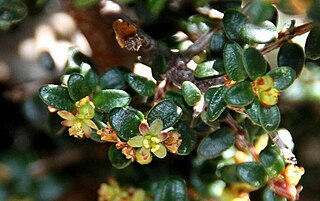
Pseudanthus orbicularis is a species of flowering plant in the family Picrodendraceae and is endemic to south-eastern continental Australia. It is a compact, monoecious shrub with simple, broadly elliptic to round leaves and creamy white, red or pale red flowers arranged singly in upper leaf axils.









